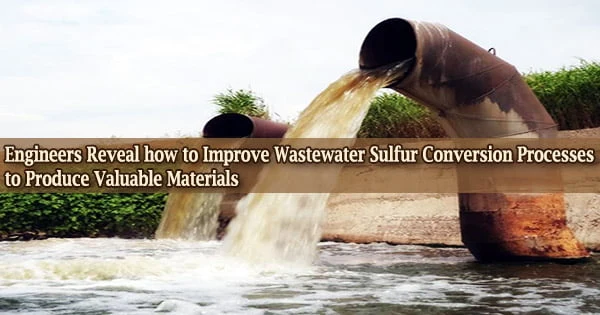One person’s garbage is another person’s gold. A new Stanford University study paves the way for sewage to be mined for valuable materials that could be used in fertilizers and batteries that could power smartphones and airplanes in the future.
The research, which was just published in the journal ACS ES&T Engineering, demonstrates how to improve electrical processes for changing sulfur pollution, and could lead to more inexpensive, renewable energy-powered wastewater treatment that produces drinking water.
“We are always looking for ways to close the loop on chemical manufacturing processes,” said study senior author Will Tarpeh, an assistant professor of chemical engineering at Stanford. “Sulfur is a key elemental cycle with room for improvements in efficiently converting sulfur pollutants into products like fertilizer and battery components.”
A better solution
As freshwater supplies become scarce, particularly in arid areas, the focus has shifted to creating wastewater-to-drinkable-water technology. Membrane systems that filter wastewater in anaerobic or oxygen-free settings are particularly promising since they utilize very little energy.
Sulfur is a key elemental cycle with room for improvements in efficiently converting sulfur pollutants into products like fertilizer and battery components.
Will Tarpeh
However, these reactions produce sulfide, a poisonous, caustic, and odorous chemical. Chemical oxidation or the use of particular chemicals to transform sulfur into separable particles, for example, can generate byproducts and induce chemical processes that damage pipes and make it more difficult to disinfect the water.
Converting sulfide to compounds utilized in fertilizer and cathode material for lithium-sulfur batteries is a tantalizing approach for dealing with anaerobic filtration’s sulfide output, but the methods for doing so are currently unknown.
As a result, Tarpeh and his colleagues set out to develop a cost-effective method that produced no chemical waste. The researchers concentrated on electrochemical sulfur oxidation, which takes little energy and allows for fine-tuning of the final sulfur compounds.
The procedure may be powered by renewable energy and customized to treat wastewater collected from individual buildings or entire cities if it proved to be effective.
The researchers assessed the speeds of each phase of electrochemical sulfur oxidation, as well as the types and amounts of products generated, using scanning electrochemical microscopy, a technique that allows for microscopic pictures of electrode surfaces while reactors are running.
They discovered the key chemical hurdles to sulfur recovery, such as electrode fouling and the most difficult intermediates to convert. They discovered that changing operating factors like reactor voltage could help with low-energy sulfur recovery from wastewater, among other things.
Energy efficiency, sulfide removal, sulfate production, and time were all clarified as a result of these and other discoveries. The researchers used them to develop a paradigm for future electrochemical sulfide oxidation procedures that balance energy input, pollution removal, and resource recovery.
Sulfur recovery technology could be integrated with other approaches in the future, such as nitrogen recovery from wastewater to generate ammonium sulfate fertilizer.
The Codiga Resource Recovery Center, a pilot-scale treatment facility on Stanford’s campus, will almost certainly play a key role in speeding up the development and implementation of these technologies in the future.
“Hopefully, this study will help accelerate adoption of technology that mitigates pollution, recovers valuable resources and creates potable water all at the same time,” said study lead author Xiaohan Shao, a PhD student in civil and environmental engineering at Stanford.





